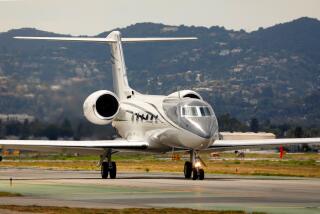What’s Up With Clean Air Aloft?
- Share via
Flight attendant Pamela Jones of Laguna Niguel dreads this time of year. “I’m sick every winter,” said Jones, during a recent telephone interview conducted while she was at home recovering from bronchitis. Jones regularly greets planeloads of sneezing, coughing, feverish passengers, especially during winter months.
At least three times a year, all that exposure to germs takes its toll and Jones--a 23-year airline veteran--calls in sick. She puts much of the blame on the quality of cabin air. If airlines would just circulate more fresh air, Jones is convinced, her sick days would dwindle. Many passengers, of course, would second that motion, but environmental experts say it’s not that simple.
Depending on the type of illness, according to Dr. James W. Mosley, USC professor of medicine in the division of infectious diseases, transmission may more likely occur from contact with a fellow passenger than from contaminated recirculated air.
For other passengers, air-quality problems aloft aren’t related to air circulation but rather to disinfection: the practice of spraying insecticide in passenger-filled and empty airplane cabins to prevent transporting disease-carrying and crop-damaging insects from one country to another.
While the problem of maintaining air quality aloft is far from solved, experts say, there has been significant progress. Since 1994, when the U.S. Department of Transportation began a campaign to stop spraying aboard passenger-filled airplanes, the number of countries that do so has dropped from 25 to 4, said DOT spokesman Bill Mosley.
U.S. officials contend that the practice of spraying inside airplane cabins is neither effective nor necessary. Since the routine spraying of aircraft in the United States was discontinued in 1979, there have not been any outbreaks here of diseases connected with imported insects, according to the Department of Transportation.
The countries that still allow the spraying of passenger-filled airplane cabins are Grenada, Kiribati, Madagascar and Trinidad/Tobago. But spraying of empty cabins is allowed by six other countries: Australia, Barbados, Fiji, Jamaica, New Zealand and Panama--a number that hasn’t changed since 1995.
It’s not difficult to avoid cabin spraying. All that the traveler needs to do is to avoid the countries in which spraying is the practice. More complicated is the issue of how best to control cabin air for temperature, humidity, oxygen content and purity--in order to maximize comfort and minimize bacterial and viral spread.
One part of that debate focuses on setting standards for the amount of fresh air versus filtered, recirculated air pumped into airline cabins. In 1996, the Federal Aviation Administration issued mandatory standards for new aircraft. It requires that aircraft provide the equivalent of 10 cubic feet of fresh air per minute per person. (A well-ventilated office building, by contrast, has an air turnover rate of about 20 cubic feet per minute per person, said Larry Holcomb, an environmental consultant in Olivet, Mich.)
But U.S. Rep. Jerrold Nadler of New York doesn’t think the FAA standard is adequate. In November, Nadler and another representative, Tom Campbell of California, reintroduced the Aviation Clean Air Act, first presented to Congress in 1994.
The bill (H.R. 2856) calls for airplane ventilation systems that provide not less than 20 cubic feet of fresh air per minute per person.
What do aircraft now supply? It varies, but on American Airlines, for example, the ventilation system replaces outside air at an average of 10 cubic feet per minute, per person, said a spokeswoman. On United Airlines, the ventilation system replaces outside air at the rate of 9 to 15 cubic feet per minute, per person, according to the airline.
On Boeing 757s, 17 cubic feet of air per minute per person is provided, said a spokeswoman for Boeing Commercial Airplane Group, Seattle. On Boeing 737-400s, 20 cubic feet of air per minute per person is provided, including both outside and filtered, recirculated air.
Meanwhile, Members of the American Society of Heating, Refrigerating and Air Conditioning Engineers, some of whose members design and maintain air ventilation systems on aircraft, are trying to establish an industry standard for commercial aircraft, said Holcomb, a member of the society. Asking for 20 cubic feet of outside air is not reasonable, he contends. “Airplanes are not designed to take in that much air.”
While recirculated air has been criticized, it’s not all bad, said airline officials. For example, recirculated air contains more moisture than outside air at high altitudes, according to an American Airlines spokeswoman, and more humid air is more comfortable to breathe.
Another plus for passengers: recirculated air passes through high-efficiency particulate (HEPA) filters, which are 99.9% efficient in removing particulates down to one micron in size, according to Holcomb. But even a filtering system that good, said USC’s Mosley, could let through some viruses. Passengers should probably blame not the ventilation system, but fellow passengers, Mosley said. “For most who travel on domestic or international trips, the rhinoviruses responsible for the common cold are more likely transmitted by [person to person] contact.”
“The most likely way to get sick on an airplane is by breathing in what other people are coughing into the air,” said Dr. Shirley Fannin, director of disease control programs, Los Angeles County Department of Health Services. If people cough into a tissue, on the other hand, the organisms don’t hang suspended in the air.
The Healthy Traveler appears the second and fourth week of every month.
More to Read
Sign up for The Wild
We’ll help you find the best places to hike, bike and run, as well as the perfect silent spots for meditation and yoga.
You may occasionally receive promotional content from the Los Angeles Times.






